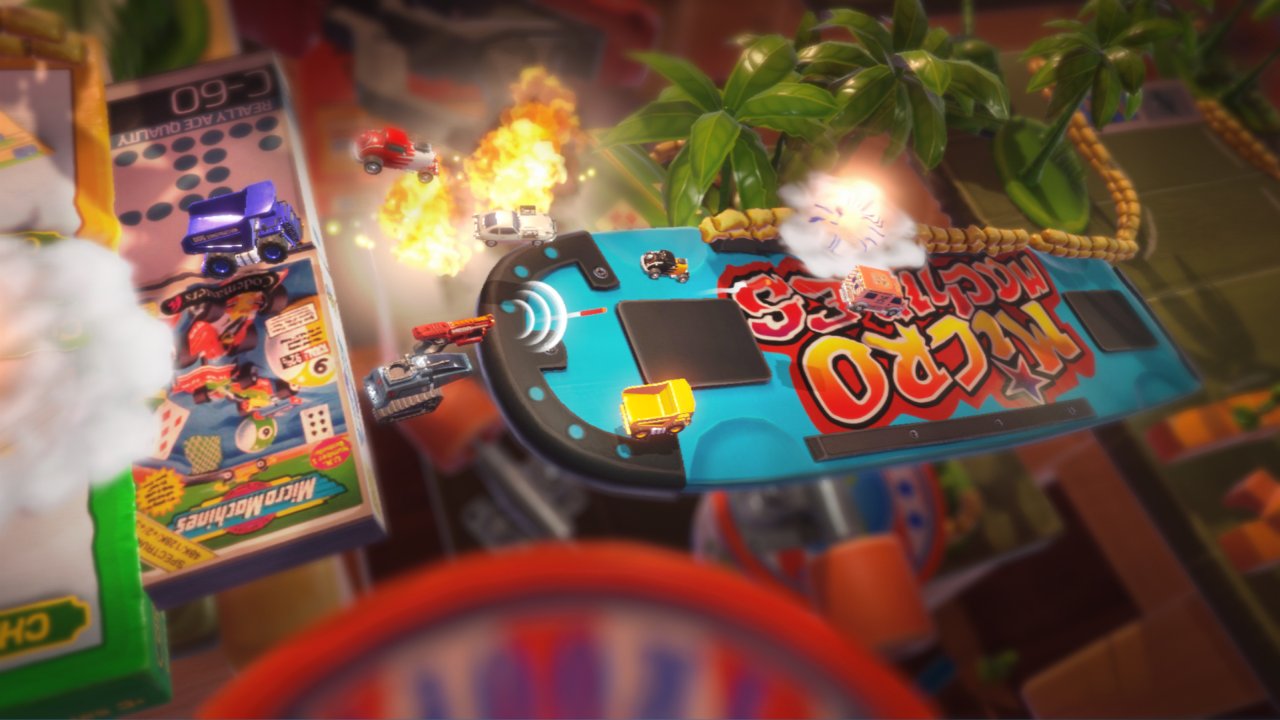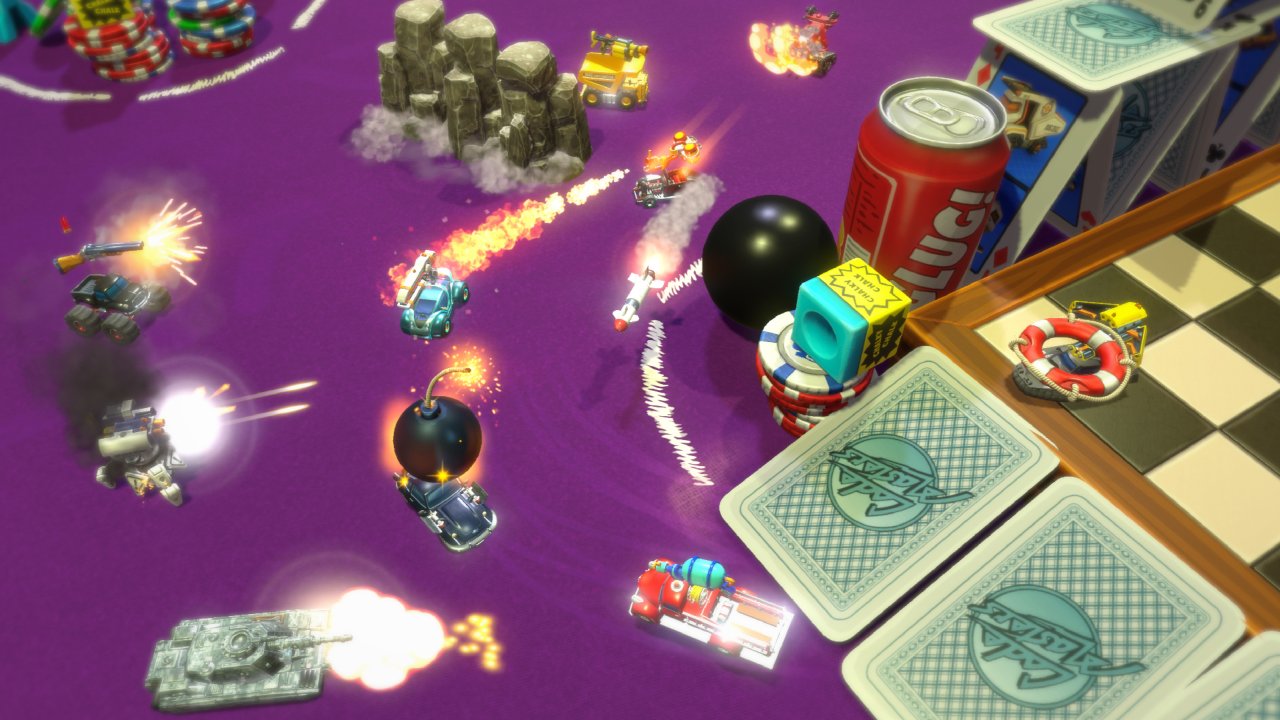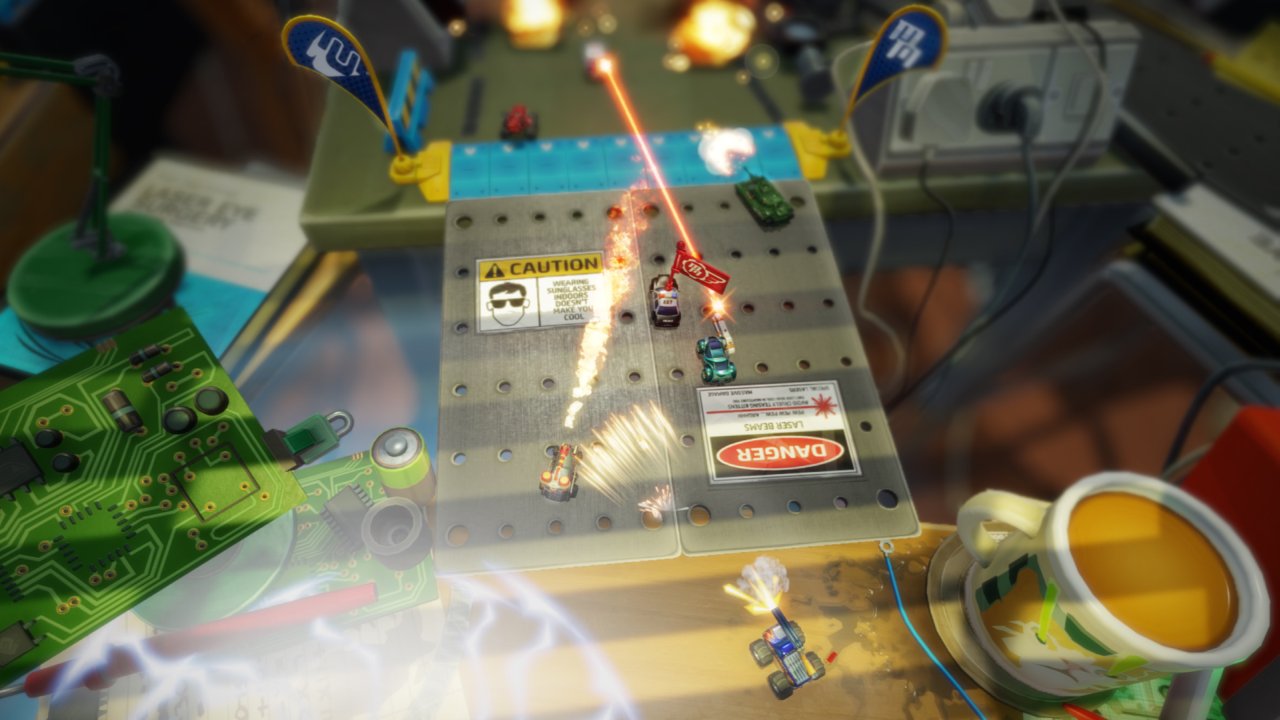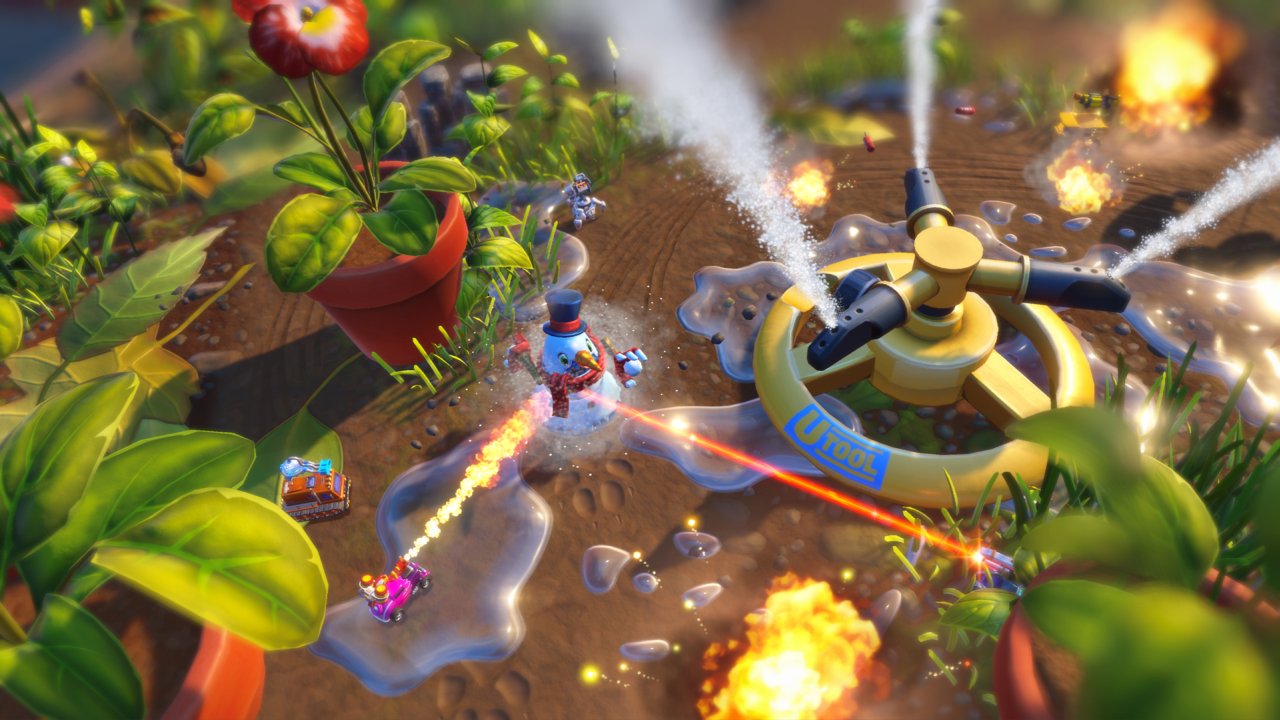Micro Machines World Series Review
Soon to be lost down the back of the couch
What a topsy-turvy world we live in. ‘Venerable’ isn’t a word I’d wager most people would apply to a series of racing games based on a line of titchy mass-produced toy cars, but nevertheless, that’s how it feels to encounter Micro Machines again after all these years. Everyone around a certain age seems to remember its original instalment with at least some degree of fondness—probably because it was ported to every last piece of hardware that Codemasters could lay their hands on—and in an age of glossy 4K tailpipe-huffing supercar simulators, the prospect of a few laps around the kitchen table in a cute bite-sized arcade racer sounds like a welcome distraction indeed. But is that all it takes these days? Does the formula that worked twenty-six years ago still brush up, or was it all cute novelty? And if you want to move it forward, where do you go?

Well, Micro Machines is now Overwatch.
Sorry. That’s maybe jumping the gun a bit, but it certainly gives you an idea of where a lot of the modern design conventions in this new instalment probably came from. Rather than everyone racing recoloured versions of the same vehicle around an appropriately themed track, there’s now a roster of a dozen distinct characters, each with their own personal transportation, tiered skins, taunts, and international accents of, uh… variable convincingness. Many of your choices of wheels are decidedly exotic—a dump truck, a snowcat, a hovercraft, a knock-off Bond-esque Aston Martin—but for the purposes of racing, their differences are more or less skin-deep. Playing online matches lets you level up, levelling up gets you loot boxes, and loot boxes get you four randomly selected cosmetics each, with in-game currency as compensation for duplicates. It all feels just a little too familiar, although without the looming presence of microtransactions, the system seems to be largely in place just to provide some semblance of a progression structure. Imitation, flattery, etcetera etcetera.
You can probably deduce from this that my hopes of a substantial single-player mode have gone up in exhaust fumes, and you’d be bang on. While you can set up local matches with the AI, it’s clear that Micro Machines is gunning more for the position of ‘beloved modest multiplayer standby’, and though I’m not one to hold a grudge against a game for forcing me to play with the other kids in the schoolyard, the least it could do is let me be a bit more choosy. Quick Play and Ranked modes both dump you into a queue without so much as letting you choose your region—a crime that I, stranded on Australia’s arse-backwards west coast in one of the most remote large cities in the world, particularly resent—and if you’d like to play on particular tracks, or without AI players, or maybe even without weapons enabled, then you can rack off back to the local modes, you picky pansy, because those aren’t options either. Initially I was impressed with the queue times, which are actually quite reasonable for a smallish multiplayer release, but it turns out that Micro Machines cheats here: if you’re waiting for noticeably longer than the estimated queue time, it just crams AI opponents into the empty slots and sends you off like that. On the overwhelming majority of occasions, this meant that my ‘multiplayer’ races consisted of me and a grid full of dumb automatons, with an occasional fellow player or two tail-sliding away somewhere out in front. The things I’ll do for experience points.

It’s bothersome that all this is getting in the way of the racing, because at a fundamental level it all feels very nicely tuned. Vehicles are nippy and easy to get a handle on, but also just slippery enough to ensure there’s a high skill cap for those who dare to slide through every corner at full speed. Tracks are laced with a myriad of obstacles, hazards, surfaces and shortcuts, and unlike the old Micro Machines games, the camera is actually positioned far enough away to let you see them coming before you plough through them. Annoyingly, online matches are always full of precisely twelve players—that is to say, about twice as many vehicles as the first bends can usually accommodate—so it’s easy to get caught in a pile-up and momentarily taken out of the running, along with three or four other unlucky souls. The rubber-banding can get pretty tiresome at times, to the point where it feels like you’re never really able to get breathing room at the front of the pack, but it’s usually possible to hang in there as long as you’re rude enough to block your tailgaters. Allegedly each of the vehicles has unique handling—at least, according to the game’s description; there’s nothing in the game that suggests as much—but you’d need a team of physicists and an airtight chamber full of lasers to glean any kind of noticeable difference, so just play whoever you like. Or whoever you got a lucky skin drop for. Whatever.
Another integral aspect of Micro Machines’ races are the Mario Kart-style items. In a less-than-subtle example of cramming one’s products into tangentially related digital media, Hasbro have seen fit to let the Micro Machines destroy each other with miniature Nerf weapons: a hammer, a gun, and some kind of water bomb. Not exactly a huge arsenal, but we’ll roll with it. While the sprinkling of chaos might have been intended to ensure people don’t get too wrapped up in the competition, the weapons themselves feel like they have far too much impact for the tight, close-run pandemonium that the game naturally tends towards: a direct hit from the hammer or the bomb will momentarily take you out of the race entirely, and even though you respawn quickly, it’s still more than enough time to drop about half a dozen places. One may think that being able to radically upend the tables like this keeps everyone on their toes, but in practice it just means that nothing you really do matters until maybe the final lap. You can’t maintain a sizeable lead for long, so why bother, eh? Just snatch it out from under someone’s nose on the second-to-last bend.
It’s around this point that one starts to despondently ask “what makes these damn games so special, anyway?” Well, it’s about the scale, isn’t it? It’s about racing in unconventional environments, around tracks defined by household clutter, dealing with the hazards that are only hazards because they’re towering over your thumb-sized chassis. Track presentation is key, and fortunately, Micro Machines understands this. There are a variety of diminutive locales, from the back yard to the breakfast table, and a lot of care has gone into making the detailed circuits look like they were assembled impromptu out of whatever clutter was closest to hand, as kids do: ramps made from skateboards and cereal boxes, finish lines marked with scattered baked beans, side-rails made from stationery, that sort of thing. Once again, product placement shows its miserable mug, with Hungry Hungry Hippos and G.I. Joe toys placed just a little too prominently in the environments to be a coincidence, but I suppose there’s no point owning the rights if you can’t flaunt them in an appropriate context.

But as I previously, definitely not facetiously stated, Micro Machines is now Overwatch, so the focus on racing has been somewhat displaced by the inclusion of a handful of battle modes. As opposed to racing, where the characters are functionally about as differentiable as contestants on The Bachelorette, in battle modes every character gets their own unique weapon, two abilities, and an ultimate ability that’s charged by engaging in combat. While there is a free-for-all mode, the interplay between abilities—and the existence of one or two wholly support-focused characters—makes it fairly clear that they were designed around the objective-driven team-based modes, which have you engaging in the time-honoured acts of territory control, capture-the-flag, and tug-o’-war. Except, you know, with toy cars.
Now then, as far as measures guaranteed to induce vehicular mayhem go, giving everyone a unique skillset and telling them to all chase the same objectives is like throwing a lukewarm French fry into a gaggle of expectant seagulls, which—depending on how you look at it—may be exactly the kind of unhinged chaos you want. As always with games that use this sort of hero-centric design pattern, there’s a steep learning curve as you struggle to memorise what every character is capable of and parse their effects from the kaleidoscopic mess on-screen, but even past that bump, I’m not convinced the combat has much of a future. A lot of work has clearly gone into making each character’s skillset interesting and thematically appropriate, but when everyone’s zooming around in cars—even nippy little cars that can quite literally turn on a sixpence—it doesn’t really feel like there’s any room for the smart positioning or careful setups that bring out the most of those skillsets; just a load of people driving haphazardly in circles, firing at each other’s back wheels and activating abilities willy-nilly. With a less-than-informative minimap and no means of panning the camera around, your situational awareness is that of a geriatric crossing the road in a very large sombrero, making it all too easy to get blindsided by somebody careening in from the edge of the screen. Maybe we just weren’t very good, and a sufficiently competitive, coordinated team could make me eat my words, but who, pray tell, is chomping at the bit to play competitive Micro Machines battle mode?
This is sort of getting at my root problem with Micro Machines World Series, which is that it just doesn’t feel like it has any real replayability to it. With functionally near-identical vehicles, rigid matchmaking settings and a fairly meagre track selection, the sense that you’ve seen it all arises very quickly indeed, and while the core racing isn’t bad, it’s not so exhilarating that I was jumping up and down to see it all again. Racing games usually don’t have trouble stretching their content out—you only have to watch someone struggling with a mirrored version of a course to see how a small change can fundamentally alter the experience—but all you get here is a grindstone to slowly eke out cosmetic unlockables from, which aren’t exactly what you’d call game-changing. Without a substantial single-player mode—sorry, sorry, I’ll stop harping on it soon, I promise—or much in the way of tweakable multiplayer, features like different AI difficulty, speed settings and tournaments are entirely absent. A special ‘event’ mode promises to put a new spin on the rules every weekend, but aside from the obvious questionable move of only opening the gates for two days a week—who are you to presume when I have free time, Codemasters?—the only example of this I witnessed was a version of battle mode with all the ability cooldowns cut in half. That is to say, a mess.

Micro Machines World Series feels like a child pushed out into the world too soon: underdeveloped, confused, and more than a little bit lost. I’ve joked about the Overwatch parallels, yes, but they’re indicative of a very real shift in focus that doesn’t quite pan out. All the basic functionality is there for an evening on the couch with your friends, doing donuts around the donuts and side-swiping people into saw blades, but instead of focusing on that experience and elevating it above mediocrity, the game fumbles around with ill-fated online features that are either stunted or entirely unappealing. There’s a decent racing experience in here, polished and tweaked until it ticks over nicely, but the game doesn’t take it anywhere; it just idles there on the treadmill, going through the same handful of tracks with the same-handling vehicles, trying to keep you there with the promise of meaningless baubles, forever.
Maybe the classic Micro Machines formula would’ve held up. Maybe it wouldn’t. Thanks to World Series, I suspect we’ll never know.
 Comments
Comments

















